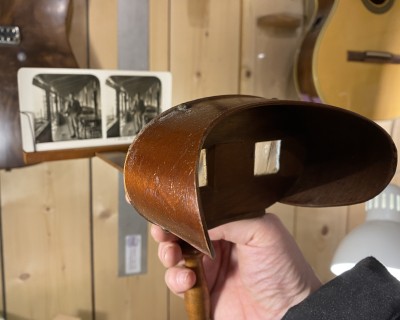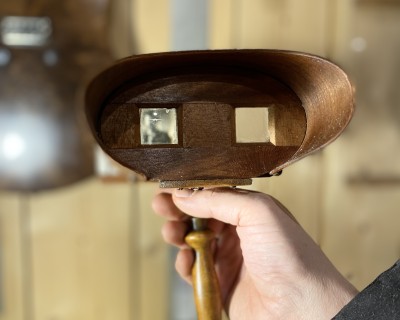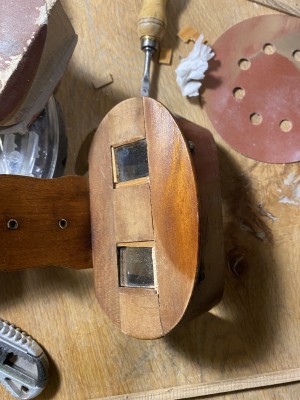Restoring a 3D photo viewer
Repairs, maintenance and upgrades
I bought this century old viewer locally via ebay. It needed some TLC. So that made it a one-evening-project.
It belonged to a school, the seller said. It seems to have been handmade. It's a bit oblique in every way possible.
It has a beak, on which a paper holder can slide front to back. There was a standard size for 3D postcards. It works with two prisms, making the brain think that the images overlap when you look through it. The prisms also enlarge. About +3, so I can just about focus on the images when the holder is on it's very end.

The viewer is different from the view master in that you look at prints rather than through slides.
One thing about my own vision is that my eyes do not seem to overlap nicely. I have hard time looking through binolculars, because of this. But since I had to fix the mounts the prismes of this viewer anyway, I took the liberty to raise one glass and lower the other. Why wouldn't I? The defect was a feature, not a problem.

It was a feature that both lenses could be relocated in their sockets
Oddly, the prisms were mounted from the front, keeping the inside much more neat than the outside. A bit of brown felt tip pen made it a wee bit prettier. I actually like its asymetric looks, though.

Look how well crafted the inside is!
Once it was optically sound, the wood needed work. The edge that goes against the face was missing a chip. I sanded it down until it was smooth. Then I made is more symetric, which made the whole thing somewhat wider. I worked on it until it fit me better.
It was a bit moldy here and there, so I sanded those parts clean. Then I oiled the whole unit with the same oil that I use on my (bass)guitar necks. Is smells good now.

Citrus oil smells good.
I was planning to make an extension so the cardholder can sit a bit farther away from the prism, but then I realized I can also use the viewer on my computer screens, so the length is perfect for me as it is.

You can see one eye only because of the prisms.
The last thing to fix was the hand grip. It folded to the front, under the beak. That must have been a mistake, because if you put your head to it, you would push it over. I carfully pried the brass rivets open, and flipped the handle over, then closed the rivets again. One snapped a bit, so I soldered it.

The grip now folds back like this
Hi res nostalgia
The nice thing about these images is that their resolution is way better than those of screens. You get a realistic view into the past. That's what hi res nostalgia brings us. Here is a nice history of these devices.
I will add a few scans one day. I have one of a gletcher. 3D wise it is not so interesting, as it works best with items in the front against a complicated backdrop, and this image is all backgroud, no foreground. But it is a thing of the past, that gletcher.
And there is one of a marketplace that is remarkably good. I will surely add that one.
I might make a camera for it. Or a set of mirrors for an existing camera. I am figuring out how to do this.

The box with about thirty images.
"These stereoscopic photographs are so true to nature and so lifelike in their portrayal of material things, that after viewing such a picture and recognizing in it some object like a house, for instance, we get the impression, when we actually do see the object, that we have already seen it before and are more or less familiar with it. In cases of this kind, the actual view of the thing itself does not add anything new or more accurate to the previous apperception we got from the picture, so far at least as mere form relations are concerned.
- Hermann von Helmholtz, Physiological Optics, 1867
Form is henceforth divorced from matter. In fact, matter as a visible object is of no great use any longer, except as the mould on which form is shaped. Give us a few negatives of a thing worth seeing, taken from different points of view, and that is all we want of it. Pull it down or burn it up, if you please."
- Oliver Wendell Holmes, The Stereoscope and the Stereograph in The Atlantic Monthly, June 1859